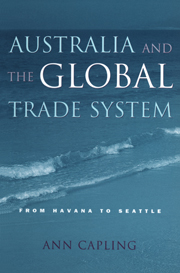Book contents
- Frontmatter
- Contents
- List of Tables and Figures
- Acknowledgments
- List of Abbreviations
- Introduction
- 1 ‘The Enfant Terrible’: Australia and the Reconstruction of the Multilateral Trade System
- 2 Coming to Terms with Multilateralism
- 3 Damage Control, Policy Stasis and Diplomatic Paralysis
- 4 Policy Innovation, Diplomatic Departures and the Uruguay Round
- 5 The Cairns Group
- 6 Aggressive Multilateralism: Negotiating Services
- 7 The American Way? Aggressive Bilateralism in Australian Trade Policy
- 8 The WTO System in Crisis
- Conclusion
- Appendix 1 Departments and Ministers responsible for GATT/WTO Negotiations
- Appendix 2 GATT Trade Runds
- Notes
- Index
1 - ‘The Enfant Terrible’: Australia and the Reconstruction of the Multilateral Trade System
Published online by Cambridge University Press: 07 October 2011
- Frontmatter
- Contents
- List of Tables and Figures
- Acknowledgments
- List of Abbreviations
- Introduction
- 1 ‘The Enfant Terrible’: Australia and the Reconstruction of the Multilateral Trade System
- 2 Coming to Terms with Multilateralism
- 3 Damage Control, Policy Stasis and Diplomatic Paralysis
- 4 Policy Innovation, Diplomatic Departures and the Uruguay Round
- 5 The Cairns Group
- 6 Aggressive Multilateralism: Negotiating Services
- 7 The American Way? Aggressive Bilateralism in Australian Trade Policy
- 8 The WTO System in Crisis
- Conclusion
- Appendix 1 Departments and Ministers responsible for GATT/WTO Negotiations
- Appendix 2 GATT Trade Runds
- Notes
- Index
Summary
The international institutions established after World War II have been rather loftily likened by Dean Acheson in his memoirs to the Creation of the world. The fact that there were others also present at the creation has not loomed large in the American retelling of the story. As a result, the establishment of the multilateral trade system is often misrepresented as a singular American achievement, whereas the reality is that the establishment of the multilateral trade system was an achievement shared among nations, and the result of hard-fought compromises between competing visions for the postwar trading system. Australia was one of the countries that had a deep interest in international trade: this chapter shows how Australia played a major part in determining the rules and norms of the emerging multilateral trade system.
In December 1945 the United States presented its vision for the reconstruction of the multilateral trade system. The United States proposals invoked the provisions of Article VII of the wartime Mutual Aid agreements which had committed the Allies to promote trade liberalisation and non-discrimination in international commerce after the war. The principle of non-discrimination in trade was the sine qua non of the proposals: its aim was to prevent a return to the hostile economic blocks that had characterised the international trade system prior to the war. Ironically, the greatest supporter of multilateralism and non-discriminatory trade relations, the United States, had been largely responsible for instigating the breakdown of the multilateral trade system before the war.
- Type
- Chapter
- Information
- Australia and the Global Trade SystemFrom Havana to Seattle, pp. 13 - 35Publisher: Cambridge University PressPrint publication year: 2001



